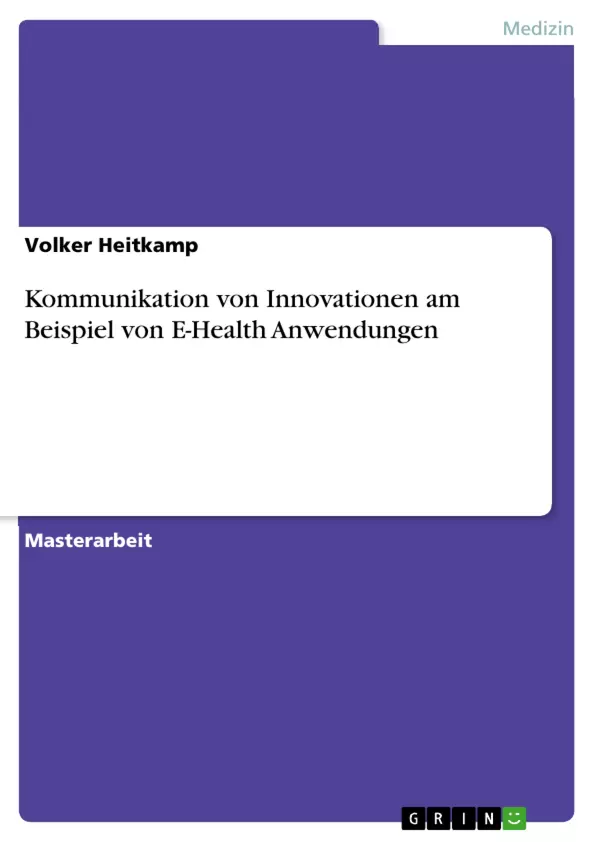Summary: The communication of innovation in the field of e-health follows the distinct concept of innovation referring to a model of Rogers. The diffusion of innovation is a five step model. First the audience has to get the knowledge of the innovation. Second they have to be convinced with further arguments and information on the concrete innovation. This phase is followed by the decision. Then they have to realise the implementation of this innovation into their daily life. To end up the implementation process there has to be a conformation.
This thesis proofs this diffusion model of Rogers in the field of e-health-commodities. It shows strength and weakness, opportunities and threats of several e-business tools. It argues on several instruments of e-health and separates them from telemedicine. Communication for the acceptance of such innovation has to take into account the different likes and non-likes of the focus-groups in the healthcare sector. Patients of different age and gender, physicians and hospital administrators accept innovations in very different ways. This study tries to show, which guidelines and approaches communication concepts have to follow, if implementation of new e-health commodities should be successful. People decide on their own relevance and attitude scale. Therefore the social implementation of e-health innovations should integrate their hopes and fears into the process. This way may succeed better then others. Nevertheless the care of sensible medical data is important, the concept of open-innovation is mentioned. First steps and hind sights of the utilization for the e-health business are given.
Inhaltsverzeichnis
- Einleitung
- E-Health-Anwendungen
- E-Health und das Gesundheitswesen
- Begriffe und Definitionen
- Vermarktung von Dienstleistungen
- E-Health – Die Rahmenbedingungen
- Einbettung in die Gesundheitswirtschaft
- E-Health und das Gesundheitswesen
- Innovationen
- Der verwandte Innovationsbegriff
- Grundlagen für die Diffusion von Innovationen
- E-Health-Anwendungen als Innovation
- Merkmale erfolgreicher Diffussionsprozesse
- Zu,,Diffusion of Innovation“ nach Rogers
- Kommunikation
- Konstruktionen von Wirklichkeit -Der Beitrag der Kommunikationstheorie
- Zur Kommunikation von Innovationen
- Kommunikation von E-Health-Innovationen
- Kommunikation und (Unternehmens-) Kultur
- Unique Selling Proposition (USP)/Unique Communication Proposition (UCP)
- Kommunikation und E-Health-Anwendungen
- Europäische und kulturelle Grundlagen – empirische Ergebnisse
- SWOT-Analyse der untersuchten E-Health-Anwendungen
Zielsetzung und Themenschwerpunkte
Die Masterarbeit beschäftigt sich mit der Kommunikation von Innovationen im E-Health-Bereich. Dabei wird der Fokus auf die Verbreitung und Akzeptanz von E-Health-Anwendungen gelegt. Die Arbeit untersucht die verschiedenen Phasen der Innovationsspreitung nach dem Modell von Rogers und analysiert, wie diese im E-Health-Kontext relevant sind.
- Diffusion von Innovationen im E-Health-Bereich
- Kommunikationsstrategien für die Akzeptanz von E-Health-Anwendungen
- Einflussfaktoren auf die Nutzung von E-Health-Diensten
- Herausforderungen und Chancen der E-Health-Kommunikation
- Analyse der SWOT-Faktoren verschiedener E-Health-Anwendungen
Zusammenfassung der Kapitel
Die Einleitung führt in das Thema der E-Health-Kommunikation ein und stellt die Relevanz der Arbeit dar. Kapitel 2 erläutert den Begriff der E-Health und untersucht verschiedene E-Health-Anwendungen im Kontext des Gesundheitswesens. Kapitel 3 befasst sich mit dem Innovationsbegriff und der Diffusion von Innovationen, insbesondere im Hinblick auf E-Health-Anwendungen. Kapitel 4 untersucht die Rolle der Kommunikation bei der Verbreitung von Innovationen und fokussiert auf die Herausforderungen und Chancen der Kommunikation von E-Health-Innovationen.
Schlüsselwörter
E-Health, Innovation, Diffusion, Kommunikation, Akzeptanz, Gesundheitswesen, E-Business, Telemedizin, Patientenkommunikation, SWOT-Analyse.
- Quote paper
- MBA, M.A. Volker Heitkamp (Author), 2007, Kommunikation von Innovationen am Beispiel von E-Health Anwendungen, Munich, GRIN Verlag, https://www.grin.com/document/93994



